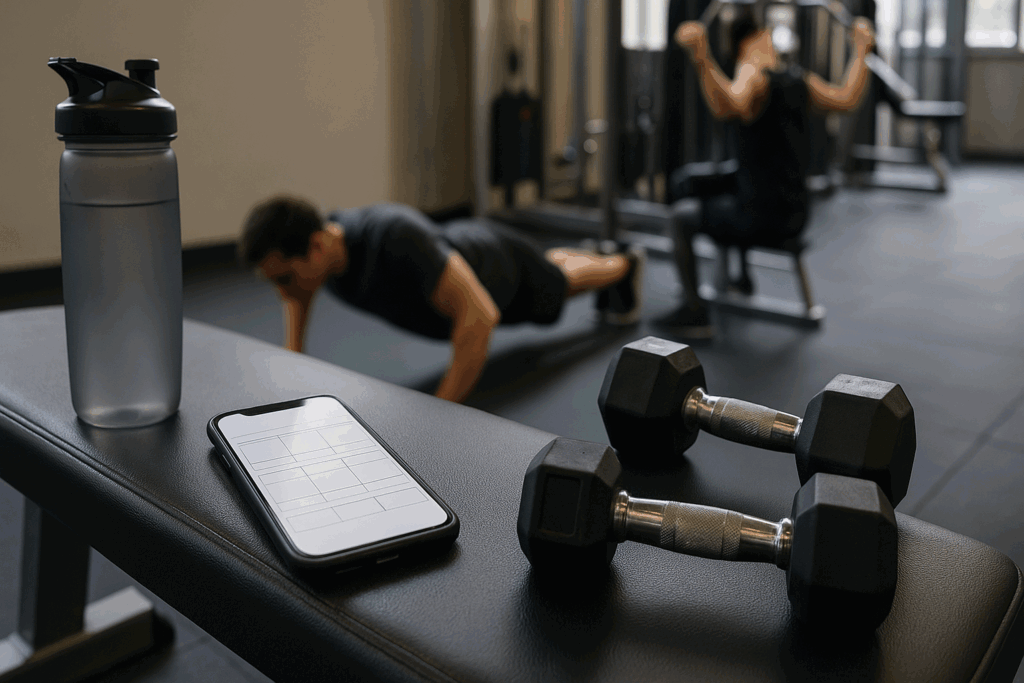Starting your fitness journey can be as exhilarating as it is overwhelming. With countless programs, routines, and theories floating around, it is easy to feel paralyzed by choice. Fortunately, a well-structured beginner gym split can provide a solid foundation for strength, muscle development, and overall physical confidence. Whether you are stepping into the gym for the first time or returning after a long hiatus, adopting a strategic approach to your workouts ensures your efforts are rewarded efficiently and safely. This article delves deeply into what makes the ultimate beginner gym split, blending scientific understanding with practical insights to help you thrive from day one.
You may also like: Does Fasting Burn Fat or Muscle? The Surprising Truth High-Protein Diets Reveal
Understanding the Importance of Structure in Beginner Gym Splits
A gym split refers to the way in which you divide your workouts across different days of the week. For beginners, a structured split is crucial not only for physical adaptation but also for developing consistency and forming habits. Without structure, many new gym-goers fall into patterns of overtraining certain muscles, neglecting others, or plateauing quickly. A beginner gym split is designed to balance all major muscle groups while allowing sufficient time for recovery, which is often underestimated by those new to weight training.
Incorporating both resistance and compound movements into the week allows for simultaneous strength gains and muscular endurance improvements. The optimal beginner weightlifting routine should avoid the complexities of advanced protocols and instead focus on progressive overload, proper form, and balanced muscle activation. With consistent application, even a simple weight workout routine can lead to impressive gains in strength and physique over time.

What Makes a Split Effective for Beginners?
An effective beginner gym split addresses several physiological and psychological factors. First and foremost, the frequency and intensity of workouts must be manageable. While enthusiasm might push you to train every day, rest and recovery are as essential as the workouts themselves. Therefore, a four-week beginner workout that schedules sessions 3-4 times per week can be more effective than a daily regimen, especially in the early stages.
Second, it should prioritize compound exercises—those that engage multiple muscle groups simultaneously. Movements like squats, deadlifts, bench presses, and rows not only build foundational strength but also promote hormonal responses conducive to muscle growth. A well-designed beginner strength training routine should place these exercises at the core, supported by accessory movements to refine technique and target secondary muscles.
Lastly, simplicity is key. The best beginner weight lifting program does not require advanced equipment, intricate cycles, or complex programming. Instead, it should be intuitive and easy to follow, fostering confidence and minimizing the risk of injury. As you progress, this foundation will support more specialized and challenging routines, but initially, clarity and consistency are more valuable than complexity.

Designing the Ultimate Beginner Gym Split for Fast Progress
Creating a practical and powerful beginner gym split involves balancing frequency, intensity, and variety. A common and highly effective structure is the three-day full-body split. Each session targets the entire body, ensuring that no muscle group is neglected. This format is ideal for those new to weight training because it reinforces movement patterns through repetition and encourages steady adaptation.
An example of a full-body weight training routine for beginners might include squats, push-ups, lat pulldowns, dumbbell rows, planks, and overhead presses. Each session would begin with a brief warm-up, perhaps five to ten minutes of light cardio and dynamic stretching, to prepare the body and mind for exertion. Following this, the workout would focus on performing three to four sets of six to twelve repetitions per exercise, a range supported by research for building both strength and hypertrophy in novice lifters.
Equally important is progression. Beginners often experience rapid strength gains—a phenomenon known as “newbie gains”—which can be optimized by gradually increasing the weight, reps, or sets over time. By tracking progress and aiming for incremental improvements each week, trainees can capitalize on their body’s heightened responsiveness to training stimuli.
Tailoring Your Routine: Flexibility Without Compromising Consistency
While structure is necessary, flexibility ensures sustainability. A rigid schedule can quickly become discouraging when life gets in the way. That is why the best beginner weight lifting program incorporates adaptability. If a three-day full-body routine becomes impractical, a four-day upper/lower body split offers a valuable alternative.
In this format, workouts are divided between upper body and lower body exercises. For example, Mondays and Thursdays might focus on the upper body with exercises such as bench presses, pull-ups, shoulder presses, and bicep curls, while Tuesdays and Fridays target the lower body with squats, lunges, deadlifts, and calf raises. This approach allows for slightly more volume per muscle group, which can be advantageous as you gain experience and resilience.
Whether using a full-body or split routine, the key is consistency. Beginning a weight training program with realistic expectations and a long-term perspective ensures that occasional missed workouts do not derail your progress. As your lifestyle evolves, so too can your training plan, provided it remains grounded in the principles of progressive overload, balance, and adequate recovery.

The Role of Nutrition in Supporting Your Training Goals
No beginner gym split can reach its full potential without appropriate nutritional support. Weightlifting beginner programs must be paired with diets that provide sufficient calories, macronutrients, and micronutrients to fuel workouts and support recovery. Protein, in particular, plays a vital role in muscle repair and growth. A general recommendation for beginners engaged in resistance training is to consume approximately 1.6 to 2.2 grams of protein per kilogram of body weight daily.
Carbohydrates, often misunderstood in modern diets, serve as the body’s primary energy source and are especially important for high-intensity training. Consuming complex carbs such as oats, brown rice, and sweet potatoes provides sustained energy and replenishes glycogen stores post-workout. Fats, too, are essential, particularly for hormonal health, with sources like avocados, nuts, seeds, and olive oil offering both calories and anti-inflammatory benefits.
Hydration, often overlooked, influences performance and recovery. Even mild dehydration can impair strength and endurance. Aim for at least eight cups of water per day, more if you are training in a hot environment or sweating excessively. Incorporating post-workout meals that combine protein and carbs can expedite recovery and minimize muscle soreness, accelerating your progression through any beginners strength training workout.

Overcoming Psychological Barriers and Building Confidence
Embarking on a new fitness journey can provoke anxiety, particularly in gym settings that may seem intimidating. However, one of the hidden benefits of following a beginner gym split is the psychological comfort that comes from having a clear plan. Knowing what to do each day reduces uncertainty and builds self-assurance. Over time, familiarity with equipment and techniques fosters a sense of competence that translates beyond the gym.
Visualization and goal-setting are powerful tools. Envisioning yourself performing lifts with perfect form or achieving personal milestones can enhance motivation and adherence. Setting realistic, measurable goals—such as increasing your squat weight by 10% in a month or attending the gym three times per week—provides direction and a sense of achievement.
Moreover, tracking progress, whether through a fitness journal or an app, reinforces positive behavior. Documenting improvements in strength, endurance, or physique can combat discouragement during inevitable plateaus. Celebrating small wins nurtures a growth mindset, which is essential for long-term commitment to any beginner weightlifting workout regimen.
Common Mistakes to Avoid When Beginning Weight Training
Despite the simplicity of a well-designed beginner gym split, several common pitfalls can hinder progress. One of the most frequent mistakes is neglecting proper form in favor of heavier weights. This not only increases the risk of injury but also limits muscular engagement, reducing the effectiveness of the exercise. Investing time in mastering technique with lighter weights pays dividends in safety and results.
Another misstep is inconsistency. Sporadic workouts, even if intense, are less effective than regular, moderate sessions. Adherence to a schedule—whether it is a simple weight workout routine or a more elaborate novice strength program—ensures cumulative progress. Additionally, failing to prioritize recovery through sleep and nutrition can stall or even reverse gains.
Overtraining is another risk, particularly for enthusiastic beginners. Muscles grow during rest, not while lifting, and insufficient recovery can lead to fatigue, mood disturbances, and reduced performance. Listening to your body, incorporating rest days, and rotating exercise intensity are key strategies to mitigate this risk.
Incorporating Cardiovascular Training for Holistic Fitness
While strength training is the cornerstone of any beginner weight lifting program, cardiovascular exercise contributes to overall health and supports recovery. Integrating low-impact cardio, such as walking, swimming, or cycling, on non-lifting days can enhance circulation, aid in muscle repair, and improve heart health.
For those interested in fat loss, combining resistance training with moderate cardio creates a calorie deficit while preserving lean mass. High-intensity interval training (HIIT), although more advanced, can be cautiously introduced after building a baseline of endurance and strength. However, the priority should remain on developing lifting proficiency, with cardio serving as a complementary rather than competing component.
Stretching and mobility work further enrich the benefits of a complete routine. Dynamic stretches during warm-ups prepare joints and muscles for load-bearing, while static stretching post-workout can reduce stiffness and improve flexibility. Yoga or mobility sessions once or twice a week can counterbalance the rigidity of strength training and promote long-term joint health.

Progressing Beyond the Beginner Stage: When and How to Advance
One of the most exciting aspects of strength training is the visible and measurable progress that occurs with consistent effort. Eventually, however, the body adapts to the initial stimulus, and progress slows. Recognizing when it is time to evolve your routine is crucial for continued development. Signs include stalled strength gains, lack of muscle soreness after workouts, or diminished enthusiasm for your current regimen.
At this juncture, transitioning to an intermediate or specialized program can reignite progress. Options include push-pull-legs splits, upper/lower body emphasis, or periodized routines with fluctuating intensity and volume. The knowledge and experience gained through your beginner strength routine will inform these decisions, enabling smarter and more personalized programming.
Adding variation through new exercises, equipment, or training modalities keeps workouts engaging and challenges muscles in different ways. However, the core principles remain unchanged: consistency, progressive overload, proper nutrition, and adequate recovery. These fundamentals, established during the beginner phase, will continue to serve you as your goals evolve and your confidence grows.
Frequently Asked Questions About the Ultimate Beginner Gym Split
How does a beginner gym split compare to a full-body training program for long-term progression?
While a full-body weight training routine for beginners is often recommended for the first few weeks, a structured beginner gym split becomes increasingly beneficial as strength and endurance improve. A full-body format allows frequent practice of foundational lifts and helps build overall neuromuscular coordination. However, as lifters begin to plateau, shifting to a beginner gym split can offer increased volume and targeted focus for specific muscle groups. This transition promotes better muscle hypertrophy and provides more recovery time per muscle group, which becomes essential as training loads intensify. For long-term success, alternating between the two formats periodically can help prevent adaptation and reignite gains.
What psychological benefits can come from beginning weight training with a structured split?
Embarking on a beginner strength workout doesn’t just influence your body—it reshapes your mindset. A structured approach to beginning weight training instills discipline, routine, and a sense of progress, all of which positively impact mental health. Knowing what to expect each gym session alleviates anxiety and builds gym familiarity, especially for those intimidated by fitness environments. Over time, achieving milestones in a beginner weightlifting routine boosts self-efficacy, confidence, and goal-setting skills that can spill over into other areas of life. This mental transformation often precedes or even accelerates physical changes, making the psychological uplift an underrated yet powerful result of a consistent weight training program for beginners.
What unique advantages does a four week beginner workout offer over more advanced training blocks?
A four week beginner workout is a highly focused and digestible plan that emphasizes rapid adaptation and neural efficiency rather than muscular complexity. In contrast to advanced programming that relies on nuanced periodization, this short-term program simplifies variables so beginners can focus on learning proper technique and developing training consistency. It serves as a low-pressure way to test recovery capacity, diet compatibility, and exercise preference without overwhelming the trainee. The psychological benefit of a fixed timeline also promotes goal adherence and makes tracking progress more tangible. Because of its straightforward structure, this format can act as a confidence builder and launchpad for transitioning into a more detailed beginner weight lifting program afterward.
How can I adjust my beginner strength training routine if I have limited equipment at home?
A beginner strength training routine can be remarkably versatile even when constrained by minimal equipment. Resistance bands, adjustable dumbbells, and bodyweight variations can replicate the movement patterns of traditional gym machines. For example, push-ups can replace bench presses, goblet squats can substitute for barbell squats, and resistance band rows can simulate cable exercises. What matters most is maintaining progressive overload and proper form, regardless of the tools used. Creativity in programming can ensure that strength training for beginners remains effective in any setting, provided that rest intervals, intensity, and muscle engagement are properly managed.
Beginner Gym Split and Recovery: How Much Rest Is Enough?
One of the most overlooked components of a beginner gym split is rest and recovery, especially for those eager to train daily. Unlike advanced athletes who may handle high-volume sessions multiple times a week, beginners benefit more from training three to four times weekly, with at least 48 hours between working the same muscle group. This spacing supports the physiological repair of microtears in muscle tissue, a key driver of growth in any muscle building program for beginners. Sleep quality, hydration, and nutrition further influence recovery outcomes, often more than the training itself. Monitoring fatigue, joint soreness, and motivation levels can help tailor rest intervals for better long-term compliance and results.
What role does progressive overload play in a beginner weightlifting workout?
Progressive overload is the cornerstone of any effective beginner weightlifting workout. It refers to gradually increasing the demands placed on the musculoskeletal system, typically through added weight, increased reps, or reduced rest intervals. For a novice strength program to yield noticeable improvements, this principle must be applied consistently yet cautiously. Beginners are uniquely positioned to benefit from even small changes in stimulus, which can lead to quick strength gains known as “newbie gains.” The challenge lies in balancing overload with recovery, ensuring each new demand builds the body up rather than breaking it down.
Can a simple weight workout routine still promote muscle definition and fat loss?
Yes, a simple weight workout routine can effectively contribute to muscle definition and fat reduction, especially when paired with a calorie-conscious, nutrient-rich diet. Weightlifting beginner programs that prioritize compound movements elevate the metabolism for hours post-workout, creating a favorable hormonal environment for fat loss. Even without complex supersets or circuit-style formats, strength building for beginners stimulates lean muscle mass growth, which in turn raises basal metabolic rate. Including moderate-intensity cardio on alternate days and ensuring consistent caloric intake can enhance the aesthetic benefits of a beginner strength training routine without complicating the workout itself.
Beginner Gym Split vs. Full-Body Routines: Which Is Better for Busy Professionals?
For time-constrained individuals, the choice between a full-body program and a beginner gym split hinges on weekly schedule flexibility. A full-body weight workout for beginners requires fewer total sessions, making it ideal for those who can only commit to three gym visits per week. However, a beginner gym split allows shorter, more focused sessions that can be squeezed into tight time blocks more easily. It also offers better recovery for individual muscle groups, reducing post-exercise soreness that might interfere with work performance. Ultimately, tailoring frequency and intensity based on your lifestyle is more important than the format itself, especially in the context of a starter weight training program.
What are some emerging trends in beginner weightlifting program design?
The landscape of beginner weightlifting programs is evolving with new technologies and research-driven approaches. One trend gaining traction is the use of wearable tech and mobile apps to personalize weight training programs for beginners in real time. These tools provide immediate feedback on form, tempo, and rest intervals, enhancing learning curves. Another innovation is the rise of virtual coaching communities that deliver accountability and support, even for those training in solitude. Periodization models like DUP (Daily Undulating Periodization) are also being simplified for beginners, offering structured variation without overwhelming complexity. These shifts make weight lifting training for beginners more accessible, data-driven, and customizable than ever before.
Can I combine cardio with my beginner weight lifting program without compromising gains?
Integrating cardio into a beginner weight lifting program can be highly beneficial when structured correctly. The key is to separate high-intensity cardio from weight training sessions to avoid central nervous system fatigue. Low-impact options such as brisk walking, cycling, or swimming can support cardiovascular health and aid recovery without interfering with strength gains. Performing cardio on alternate days or after lifting sessions is ideal for preserving muscle mass while enhancing endurance. By maintaining moderate volume and adjusting caloric intake accordingly, you can simultaneously pursue fat loss and strength building for beginners without one undermining the other.
Conclusion: Building a Strong Future with the Right Foundation
The journey through a beginner gym split is more than just a physical transformation; it is the forging of discipline, resilience, and self-awareness. By embracing a structured, evidence-based approach to training, you not only build muscle and strength but also lay the groundwork for a lifetime of health and wellness. Whether your goal is aesthetic improvement, functional strength, or overall vitality, the right beginning can make all the difference.
Through deliberate practice, attention to form, and a commitment to consistency, anyone can master the basics of weight training. Incorporating strategies such as proper nutrition, goal-setting, and mobility work enhances results and prevents common pitfalls. As you transition from novice to experienced lifter, the skills and habits cultivated during your early days will continue to guide your progress.
Ultimately, strength training for beginners is not about perfection but about progression. Each lift, each session, each meal is a step toward a stronger, healthier you. With the ultimate beginner gym split as your blueprint, you are equipped not only to begin your journey but to thrive every step of the way.
Further Reading:
The Beginner Weight Training Workout Routine





